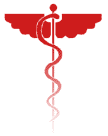 |
The LSUHSC New Orleans
Emergency Medicine Interest Group
Presents
The Student Procedure Manual
|
 |
Protecting Yourself and Your Patients:
Reducing Infection Risks
What factors increase the risk of medical
student occupational exposure to infection?
What medical students can do to reduce risks?
What are standard universal precautions (UP)?
Why use universal precautions?
What kind of precautions do I use?
What sort of work practices must be used?
What is meant by personal protective equipment?
Where do I find personal protective equipment?
What is meant by engineering controls?
What factors increase the risk of medical
student occupational exposure to infection?
- New Orleans is a high prevalence area for HIV, hepatitis and mycobacterium
tuberculosis (MTB).
- Local drug use increases the number of heterosexuals with HIV and hepatitis.
- MCLANO's Accident Room receives trauma victims from drug related violent crimes.
The Accident Room is an uncontrolled environment.
- Limited routine HIV testing identifies very few of the positive HIV cases at
the Medical Center of Louisiana(MCLANO). They may be admitted outside
of West 900.
- Students are at risk for contact with blood and other body substances in performing
physicals. Students touch mucous membranes such as eyes, nose, mouth, and
GU tract. Students examine lesions and wounds, draw blood, start IV's, clear
airways, and place urinary catheters.
- There is an increasing incidence of hepatitis and MTB in the community and
the hospital.
- Negative peer pressure; to some students taking appropriate precautions is
"not macho". This causes a low rate of reported exposures.
What medical students can do to reduce risks?
- Get vaccinations - Hepatitis B vaccine (HBV), Childhood diseases (especially
varicella vaccination if not immune).
- Report all percutaneous or mucosal exposures to blood or body fluids to Employee
Health, Charity Campus, E607, 568-31595 6:30 am - 3:30 pm, Monday - Friday;
after hours and on weekends or holidays, report to Fast Track, Charity Campus
Emergency Room.
- Heed isolation signs.
- Practice invasive procedures on manikins in lab under controlled conditions
at the Charity-Delgado School of Nursing.
- Review videotapes of these procedures in the LSUHSCNO Library.
- Get MTB skin test annually and 30 days after last known exposure.
- Be alert to the symptoms of MTB (productive cough, blood tinged sputum, unexplained
weight loss, night sweats). Suspect patients should be rapidly tested and airborne
isolation should be instituted (place patient in a negative pressure room and
wear a mask).
- Report unsafe practices to Infection Control 568-3153.
What are standard universal precautions (UP)?
- Blood and body fluid precautions for all patients. This means you treat all
patients as potentially infectious.
Why use universal precautions?
- It is a national standard to protect health care workers from blood born infections.
It is mandated by the Occupational Safety and Health Administration (OSHA) and
by MCLANO.
What kind of precautions do I use?
- Health Care workers must use certain work practice controls (techniques), personal
protective equipment (attire), and engineering controls (equipment) to protect
themselves and others.
What sort of work practices must be used?
- Use techniques to prevent generation of aerosols and injuries caused by sharp
objects.
- Never throw sharps in the trash, on the floor or leave them in bedding or
on tables.
- Place sharps in needle boxes. Avoid loading box with non-sharp waste like
paper towels, syringe packaging, etc.
- Avoid recapping, bending, or breaking needles by hand; avoid removing needles
from disposable syringes or otherwise manipulating needles by hand.
- If you must recap, use a single-handed recapping technique or use devices
for safe needle removal/ shielding.
- Immediately wash contaminated skin or mucous membranes.
- Remove contaminated gloves before touching other surfaces (e.g. phones, computer,
etc.)
- Wash hands even after glove removal (See hand washing below).
- Secure the lid of specimen containers to prevent leakage and avoid contamination
of the outside of the container and of lab request slips. Place specimen in
plastic bag for
transport to lab.
- Cover cuts on hand and forearms with a waterproof dressing.
- Those who have exudative lesions or weeping dermatitis should refrain from
all direct patient care and from handling patient care equipment until the condition
resolves.
- Do not eat, drink, apply contact lenses or cosmetics in patient care areas.
- Clean stethoscope and other items between patients. Do not tape blood tubes
or glass slides to stretchers or charts.
What is meant by personal protective equipment?
- Wear gloves, masks, protective eyewear or face shields, gowns and aprons when
contact with blood or other body substances is likely. All of the above items
should be worn by ALL personnel participating in major trauma resuscitations
in Trauma Room 4. With rare exceptions, anyone entering an OR or Delivery Room
during a procedure must wear protective eyewear. Supply your own eyewear.
Where do I find personal protective equipment?
- Be able to locate the storage area for these items in your unit. Carry clean,
non-sterile gloves in your pocket or pouch for emergencies. Purchase your own
eyewear with side shields for your regular use. Be able to locate reusable goggles
on the crash cart for emergency use.
What is meant by engineering controls?
- Devices that protect you from exposure to body substances. In your unit, locate
sharps boxes, emergency resuscitation devices or, mouth-to-mask devices. Identify
devices that decrease injury from sharps, e.g. safety syringes, recapping devices,
needleless tubing connectors, resheathable IV catheters and butterfly needles.
This page copyright © 1997-2002 LSUHSC EMIG. All rights reserved.



